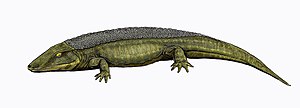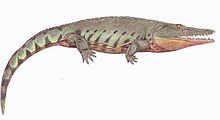Chroniosuchia
| Chroniosuchia | ||||||||||||
|---|---|---|---|---|---|---|---|---|---|---|---|---|

Chroniosuchus , a Chroniosuchier from the Upper Permian of Russia. |
||||||||||||
| Temporal occurrence | ||||||||||||
| Middle Perm to Middle Triassic | ||||||||||||
| approx. 265 to 228.7 million years | ||||||||||||
| Locations | ||||||||||||
|
||||||||||||
| Systematics | ||||||||||||
|
||||||||||||
| Scientific name | ||||||||||||
| Chroniosuchia | ||||||||||||
| Tatarinov , 1972 | ||||||||||||
Chroniosuchier are an extinct group of the Reptiliomorpha , whose members are characterized by a series of articulated skin bone plates ( osteoderms ) along the back of the body. Except for isolated occurrences from the Upper Permian of China and the Triassic of Kupferzell , Baden-Wuerttemberg, Chroniosuchier are exclusively occupied by fossil finds from Permian to Triassic continental sedimentary rocks of the European part of Russia.
Skeletal features
As with Seymouriamorpha and Diadectomorpha, but in contrast to the embolomeri , in the vertebrae of adult Chroniosuchier the neural arch was fused with the pleurocentrun. Their shape was concave on both sides ( amphicoel ), so that a spherical to ellipsoidal intercentrum fitted between two pleurocentres (cf. Vyushkov 1957, Golubev 2000).
Osteoderms of the back series, which extended from the neck to the front tail, either sat with their ventral processes on the spinous processes of the vertebrae or were fused with them. The osteoderm / vertebra allocation was strictly 1: 1. The complex articulation of two adjacent osteoderms involved forward and rearward pointing processes on the underside of the plate, which overlapped and resembled the zygapophyses of the vertebrae. The osteoderms of the Chroniosuchidae differ from those of the second subgroup, the Bystrowianidae , etc. a. due to the presence of additional paired articular surfaces. In the Bystrowianids and some Chroniosuchids, the narrow osteoderms only covered the area of the body axis, whereas in Chroniosuchus , Chroniosaurus and Jarilinus the osteoderms were wide and formed segmented carapaces (cf. Golubev 1998-2000, Novikov et al. 2000).
An unusual feature of Chroniosuchid skulls is the presence of large cranial windows (antorbital foramen) located in front of the eye opening ; later, such openings appear convergent in archosaurs . Chroniosuchiden could evidently move the cheek and upper jaw relative to the roof of the skull and with this form of the kinesis of the skull laterally expand the mouth (Golubev 2000).
Way of life
Due to their skull morphology, the frequent evidence from lake sediments and their association with fish fossils, Chroniosuchids are regarded as crocodile-like aquatic predators (Golubev 2000) - but bone histological findings contradict this (cf. Laurin et al. 2004); Bystrowianids, on the other hand, appear in the Russian fossil sites mostly in connection with vertebrates, whose way of life was not tied to the water.
Family relationships
Chroniosuchians were first identified by Vyushkov (1957a) as a separate group (family Chroniosuchidae) within the batrachosaurs , in the same year Vyushkov (1957b) established the family Bystrowianidae, but without considering them as the closest relatives of the Chroniosuchidae. Tatarinov (1972) assigned both groups to the Seymouriamorpha and created a separate subordination for the Chroniosuchids (Chroniosuchi (d) a). In their revision, Ivakhnenko and Tverdochlebova (1980) added the Bystrowianids to the Chroniosuchi as a second subgroup and justified the hypothesis that Chroniosuchi were the closest relatives of the Anthracosauria . The group of Chroniosuchier and Anthracosaurier received the name Anthracosauromorpha , which was used in most of the subsequent publications.
Internal system
- Chroniosuchidae Vyushkov, 1957
- Chroniosuchus Vyushkov, 1957
- Chroniosaurus Tverdochlebova, 1972
- Jarilinus Golubev, 1998
- Uralerpeton Golubev, 1998
- Suchonica Golubev, 1999
- Madygenerpeton Schoch, Voigt & Buchwitz, 2010
- Bystrowianidae Vyushkov, 1957
- Bystrowiana Vyushkov, 1957
- Axitectum Novikov & Shishkin, 1992
- Dromotectum Novikov & Shishkin, 1996
- Synesuchus Novikov & Shishkin, 1996
- Bystrowiella Witzmann, Schoch & Maisch, 2008
literature
- VK Golubev: Narrow-armored Chroniosuchians (Amphibia, Anthracosauromorpha) from the Late Permian of Eastern Europe. In: Paleontologicheskij Zhurnal. Volume 1998, No. 3, 1998, pp. 64-73.
- VK Golubev: Revision of the Late Permian chroniosuchians (Amphibia, Anthracosauromorpha) from Eastern Europe. In: Paleontologicheskij Zhurnal. Volume 1998, No. 4, 1998, pp. 68-77.
- VK Golubev: A new narrow-armored chroniosuchian (Amphibia, Anthracosauromorpha) from the Late Permian of the East Europe. In: Paleontologicheskij Zhurnal. Volume 1999, No. 2, 1999, pp. 43-50.
- VK Golubev: Permian and Triassic chroniosuchians and biostratigraphy of the Upper Tatarian series in Eastern Europe. In: Trudy Paleontologiceskogo Instituta. Volume 276, 2000, pp. 1-172.
- MF Ivakhnenko, GI Tverdokhlebova: Systematics, Morphology, and Stratigraphic Significance of the Upper Permian Chroniosuchians from the East of the European Part of the USSR. Izdatelstvo Saratovskogo Universiteta, Saratov 1980.
- IV Novikov, MA Shishkin: Paleozoic relics in the Triassic tetrapod communities: the last anthracosaurian amphibians. Sixth Symposium on Mesozoic Terrestrial Ecosystems and Biota. China Ocean Press, Beijing 1996.
- IV Novikov, MA Shishkin, VK Golubev: Permian and Triassic anthracosaurs from Eastern Europe. In: MJ Benton, MA Shishkin, DM Unwin, EN Kurochkin (eds.): The Age of Dinosaurs in Russia and Mongolia. Cambridge University Press, Cambridge 2000, pp. 60-70.
- GI Tverdokhlebova: New batrachosaurian genus from the Upper Permian of the southern Cis-Urals. In: Paleontologicheskij Zhurnal. 1972, pp. 95-103.
- M. Laurin, M. Girondot, M.-M. Loth: The evolution of long bone microstructure and lifestyle in lissamphibians. In: Paleobiology. Volume 30, No. 4, 2004, pp. 589-613.
- Rainer R. Schoch, Sebastian Voigt, Michael Buchwitz: A chroniosuchid from the Triassic of Kyrgyzstan and analysis of chroniosuchian relationships. In: Zoological Journal of the Linnean Society. Volume 160, No. 3, 2010, pp. 515-530.
- LP Tatarinov: Seymouriamorphs from the fauna of the USSR. In: O. Kuhn (Ed.): Encyclopedia of Paleoherpetology. vol. 5B, Gustav Fischer, Stuttgart 1972.
- BP Vjushkov: New kotlassiomorphs from the Tatarian Series in the European part of the USSR. Upper Permian cotylosaurs and batrachosaurs from the SSSR. Trudy Paleontologicheskogo Instituta Akademya Nauk SSSR, Moscow 1957, pp. 89-107.
- BP Vjushkov: New peculiar animals from strata of the Tatarian Series in the European part of the USSR. In: Doklady Akademiya Nauk SSSR. Volume 113, 1957, pp. 183-186.


